南京航空航天大学Matrix-Theory双语矩阵论期末考试2015
- 格式:doc
- 大小:314.50 KB
- 文档页数:3
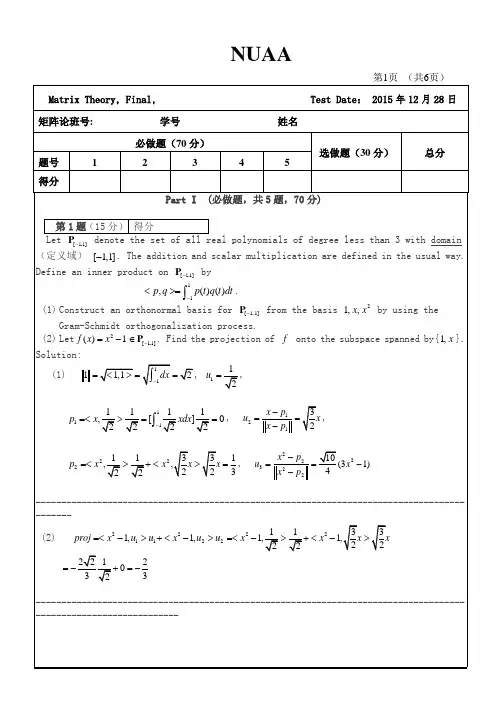
NUAALet 3P (the vector space of real polynomials of degree less than 3) defined by(())'()''()p x xp x p x σ=+.(1) Find the matrix A representing σ with respect to the ordered basis [21,,x x ] for 3P .(2) Find a basis for 3P such that with respect to this basis, the matrix B representing σ is diagonal.(3) Find the kernel (核) and range (值域)of this transformation. Solution: (1)221022x x x x σσσ===+()()() 002010002A ⎛⎫⎪= ⎪ ⎪⎝⎭----------------------------------------------------------------------------------------------------------------- (2)101010001T ⎛⎫ ⎪= ⎪ ⎪⎝⎭(The column vectors of T are the eigenvectors of A)The corresponding eigenvectors in 3P are 1000010002T AT -⎛⎫⎪= ⎪ ⎪⎝⎭(T diagonalizes A ) 22[1,,1][1,,]x x x x T += . With respect to this new basis 2[1,,1]x x +, the representingmatrix of σis diagonal.------------------------------------------------------------------------------------------------------------------- (3) The kernel is the subspace consisting of all constant polynomials.The range is the subspace spanned by the vectors 2,1x x +-----------------------------------------------------------------------------------------------------------------------Let 020012A ⎛⎫⎪= ⎪ ⎪-⎝⎭.(1) Find all determinant divisors and elementary divisors of A .(2) Find a Jordan canonical form of A .(3) Compute At e . (Give the details of your computations.) Solution: (1)110020012I A λλλλ-⎛⎫ ⎪-=- ⎪ ⎪-⎝⎭,(特征多项式 2()(1)(2)p λλλ=--. Eigenvalues are 1, 2, 2.)Determinant divisor of order 1()1D λ=, 2()1D λ=, 23()()(1)(2)D p λλλλ==-- Elementary divisors are 2(1) and (2)λλ-- .---------------------------------------------------------------------------------------------------------------------- (2) The Jordan canonical form is100021002J ⎛⎫ ⎪= ⎪ ⎪⎝⎭--------------------------------------------------------------------------------------------------------------------------(3) For eigenvalue 1, 010010011I A ⎛⎫⎪-=- ⎪ ⎪-⎝⎭ , An eigenvector is 1(1,0,0)T p = For eigenvalue 2, 1102000010I A ⎛⎫⎪-= ⎪ ⎪⎝⎭, An eigenvector is 2(0,0,1)T p =Solve 32(2)A I p p -=, 331100(2)00000101A I p p --⎛⎫⎛⎫⎪ ⎪-== ⎪ ⎪ ⎪ ⎪-⎝⎭⎝⎭we obtain that3(1,1,0)T p =-101001010P ⎛⎫ ⎪=- ⎪ ⎪⎝⎭, 1110001010P -⎛⎫⎪= ⎪ ⎪-⎝⎭ 1At J e Pe P -=22210100110001000101000010tt t t e e te e ⎛⎫⎛⎫⎛⎫⎪ ⎪ ⎪=- ⎪ ⎪ ⎪ ⎪ ⎪ ⎪-⎝⎭⎝⎭⎝⎭22220000t t t t t t e e e e tee ⎛⎫-⎪= ⎪ ⎪-⎝⎭ --------------------------------------------------------------------------------------------------------------------Suppose that ∈R A and O I A A =--65.(1) What are the possible minimal polynomials of A ? Explain.(2) In each case of part (1), what are the possible characteristic polynomials of A ? Explain.Solution:(1) An annihilating polynomial of A is 256x x --.The minimal polynomial of A divides any annihilating polynomial of A. The possible minimal polynomials are6x -, 1x +, and 256x x --.---------------------------------------------------------------------------------------------------------------(2) The minimal polynomial of A divides the characteristic polynomial of A. Since A is a matrix of order 3, the characteristic polynomial of A is of degree 3. The minimal polynomial of A and the characteristic polynomial of A have the same linear factors. Case 6x -, the characteristic polynomial is 3(6)x - Case 1x +, the characteristic polynomial is 3(1)x + Case 256x x --, the characteristic polynomial is 2(1)(6)x x +- or 2(6)(1)x x -+-------------------------------------------------------------------------------------------------------------------Let 120000A ⎛⎫=⎪⎝⎭. Find the Moore-Penrose inverse A +of A .Solution: ()12011200000A PG ⎛⎫⎛⎫=== ⎪ ⎪⎝⎭⎝⎭1()(1,0)T T P P P P +-==, 111()250T T G G GG +-⎛⎫⎪== ⎪ ⎪⎝⎭110112(1,0)2055000A G P +++⎛⎫⎛⎫ ⎪⎪=== ⎪ ⎪ ⎪ ⎪⎝⎭⎝⎭也可以用SVD 求.------------------------------------------------------------------------------------------------------------------Part II (选做题, 每题10分)请在以下题目中(第6至第9题)选择三题解答. 如果你做了四题,请在题号上画圈标明需要批改的三题. 否则,阅卷者会随意挑选三题批改,这可能影响你的成绩.Let 4P be the vector space consisting of all real polynomials of degree lessthan 4 with usual addition and scalar multiplication. Let 123,,x x x be three distinct real numbers. For each pair of polynomials f and g in 4P , define 31,()()i i i f g f x g x =<>=∑.Determine whether ,f g <> defines an inner product on 4P or not. Explain.Let n n A ⨯∈R . Show that if x x A =)(σis the orthogonal projection fromn R to )(A R , then A is symmetric and the eigenvalues ofA are all 1’s and 0’s.n n A ⨯∈C . Show that x x A H is real-valued for all n C x ∈if and only if Ais Hermitian.Let n n B A ⨯∈C , be Hermitian matrices, and A bepositive definite. Show thatAB is similar to BA , and is similar to a real diagonal matrix.若正面不够书写,请写在反面.123()()()x x x x x x ---. Then ,0f f <>=. But 0f ≠. This does not define an inner product. For any x , ()()x x T A R A N A ⊥-∈=, ()x x 0T A A -=. Hence, T T A A A =. Thus. T A A =.From above, we have 2A A =. This will imply that λλ-2is an annihilating polynomial of A. The eigenvalue of A must be the roots of 02=-λλ. Thus, the eigenvalues of A are1’s and 0’s.See Thm 7.1.1, page 182. 也可以用其它方法.Since A is nonsingular, 1()AB A BA A -=. Hence, A is similar to BASince A is positive definite, there is a nonsingular hermitian matrix P such that H A PP =. 1()H H AB PP B P P BP P -==Since H P BP is Hermitian, it is similar to a real diagonal matrix.is similar to H AB P BP , H P BP is similar to a real diagonal matrix. Thus AB is similar to a real diagonal matrix.。
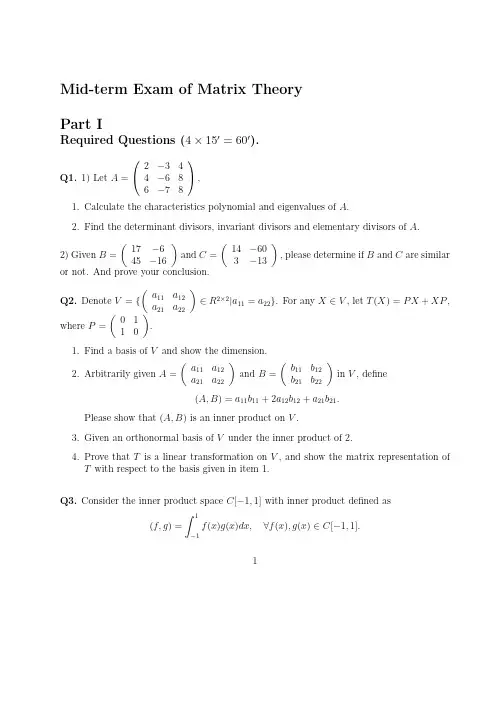
Mid-term Exam of Matrix TheoryPart IRequired Questions (4×15′=60′).Q1.1)Let A = 2−344−686−78,1.Calculate the characteristics polynomial and eigenvalues of A .2.Find the determinant divisors,invariant divisors and elementary divisors of A .2)Given B =(17−645−16)and C =(14−603−13),please determine if B and C are similar or not.And prove your conclusion.Q2.Denote V ={(a 11a 12a 21a 22)∈R 2×2|a 11=a 22}.For any X ∈V ,let T (X )=P X +XP ,where P =(0110).1.Find a basis of V and show the dimension.2.Arbitrarily given A =(a 11a 12a 21a 22)and B =(b 11b 12b 21b 22)in V ,define (A,B )=a 11b 11+2a 12b 12+a 21b 21.Please show that (A,B )is an inner product on V .3.Given an orthonormal basis of V under the inner product of 2.4.Prove that T is a linear transformation on V ,and show the matrix representation of T with respect to the basis given in item 1.Q3.Consider the inner product space C [−1,1]with inner product defined as(f,g )=∫1−1f (x )g (x )dx,∀f (x ),g (x )∈C [−1,1].11.Show that1and3x2−1are orthogonal.2.Determine∥1∥and∥3x2−1∥.3.Let S=L{1,3x2−1}be a subspace of R[x]3,find the optimal approximation of xover S.Q8.Denote R[x]3to be the vector space of zero and polynomials with degree less than3.1.Determine the dimension of R[x]3and give a basis of R[x]3.2.Define the linear transformation D on R[x]3,D(f(x))=f′(x),∀f(x)∈R[x]3.Please give the matrix representation of D with respect to the basis given in the above item.Show R(D)and ker(D).3.Prove that D is not diagonalizable.4.Define the inner product on R[x]3,(f,g)=∫1−1f(x)g(x)dx,∀f(x),g(x)∈R[x]3,please Gram-Schmidt orthogonalize the basis given in item1.Part IIPreferential Questions(2×20′=40′).Q5.For any x∈R n,several definitions are given as follows,∥x∥0=∑x i=0|x i|0,∥x∥p=(m∑i=1|x i|p)1p(0<p<1),∥x∥1=m∑i=1|x i|.(1)1.Please determine if∥x∥0,∥x∥p and∥x∥1are valid vector norms or not.And try todefense your decision.2.Especially when n=2,plot the curves of∥x∥0=1,∥x∥p=1and∥x∥1=1respectively.2Q6.Given A∈R n×n,summarize the necessary and sufficient conditions of A to be di-agonalizable,and prove at least one of them.Determine if the matrix A given in Q1is diagonalizable or not.If yes,please explain why,if not,please give the Jordan canonical form of A.Q7.Given A∈R n×n,denote W={X∈R n×n|AX=XA}.1.Show that W is a subspace of R n×n.2.DenoteD=λ10 00λ2 0............00···λn,whereλ1,λ2,···,λn are different from each other.If A=D,please determine the dimension of W.3.If A is similar to D defined as in item2,please prove that any X∈W is diagonalizable.4.Given some X∈W,if X and A are both diagonalizable,then there exists a nonsingularmatrix P∈R n×n such that P−1XP and P−1AP are diagonal simultaneously.3。
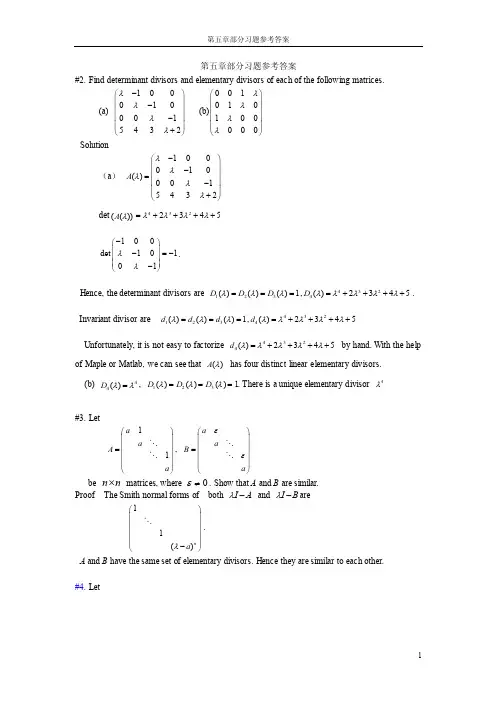
第五章部分习题参考答案#2. Find determinant divisors and elementary divisors of each of the following matrices.(a) 1000100015432λλλλ-⎛⎫ ⎪-⎪ ⎪- ⎪+⎝⎭ (b)001010100000λλλλ⎛⎫⎪ ⎪ ⎪ ⎪⎝⎭Solution(a ) 100010()0015432A λλλλλ-⎛⎫ ⎪- ⎪= ⎪- ⎪+⎝⎭det (())A λ4322345λλλλ=++++100det 10101λλ-⎛⎫⎪-=- ⎪ ⎪-⎝⎭. Hence, the determinant divisors are 123()()()1D D D λλλ===,4324()2345D λλλλλ=++++. Invariant divisor are 123()()()1d d d λλλ===,4324()2345d λλλλλ=++++Unfortunately, it is not easy to factorize 4324()2345d λλλλλ=++++ by hand. With the help of Maple or Matlab, we can see that ()A λ has four distinct linear elementary divisors. (b) 44()D λλ=, 123()()()1D D D λλλ===. There is a unique elementary divisor 4λ #3. Let11a a A a ⎛⎫ ⎪ ⎪= ⎪ ⎪⎝⎭ , a a B a εε⎛⎫ ⎪⎪= ⎪ ⎪⎝⎭ be n n ⨯ matrices, where 0ε≠. Show that A and B are similar.Proof The Smith normal forms of both I A λ- and I B λ-are11()n a λ⎛⎫ ⎪⎪ ⎪ ⎪-⎝⎭. A and B have the same set of elementary divisors. Hence they are similar to each other. #4. Let11a a A a ⎛⎫ ⎪ ⎪= ⎪ ⎪⎝⎭ , 11a a B a ε⎛⎫ ⎪⎪= ⎪ ⎪⎝⎭be n n ⨯ matrices, where 0ε≠. Show that A and B are NOT similar. ProofThe determinant of I A λ- is ()n a λ- . The determinant of I B λ- is ()n a λε--. A and B have distinct characteristic polynomials. Hence, they are not similar.#11. How many possible Jordan forms are there for a 66⨯ complex matrix with characteristic polynomial 42(2)(1)x x +-?Solution The possibilities for the sets of elementary divisors are { 42(2),(1)x x +-}, {4(2),(1),(1)x x x +--}{32(2),(2),(1)x x x ++-}, {3(2),(2),(1),(1)x x x x ++--} {222(2),(2),(1)x x x ++-}, {22(2),(2),(1),(1)x x x x ++--},{22(2),(2),(2),(1)x x x x +++-}, {2(2),(2),(2),(1),(1)x x x x x +++--}{2(2),(2),(2),(2),(1)x x x x x ++++-}, {(2),(2),(2),(2),(1),(1)x x x x x x ++++--}. For each set of elementary divisors, there is a Jordan canonical form up to similarity. There are 10 Jordan canonical forms up to similarity.#12. Classify up to similarity all 33⨯ complex matrices A such that 3A I =. Solution An annihilating polynomial of A is 321(1)()()x x x x ωω-=---, where ω A is diagonalizable.The possibilities for the minimal polynomial of A are1x -, x ω-, 2x ω-;(1x -)(x ω-), (x ω-)(2x ω-), (1x -)(2x ω-);2(1)()()x x x ωω---Up to similarity, all 33⨯ complex matrices A are100010001⎛⎫ ⎪ ⎪ ⎪⎝⎭, 000000ωωω⎛⎫⎪ ⎪ ⎪⎝⎭, 222000000ωωω⎛⎫ ⎪ ⎪ ⎪⎝⎭; 10001000ω⎛⎫⎪ ⎪ ⎪⎝⎭, 1000000ωω⎛⎫ ⎪ ⎪ ⎪⎝⎭; 22000000ωωω⎛⎫ ⎪⎪ ⎪⎝⎭, 2000000ωωω⎛⎫ ⎪ ⎪ ⎪⎝⎭;221000000ωω⎛⎫⎪ ⎪ ⎪⎝⎭,210001000ω⎛⎫⎪ ⎪ ⎪⎝⎭21000000ωω⎛⎫ ⎪ ⎪ ⎪⎝⎭#14. If N is a nilpotent (幂零的) 33⨯ matrix over C , prove that 21128A I N N =+- satisfies2A I N =+, i.e., A is a square root of I N +. Use the binomial series for 1/2(1)t + to obtain asimilar formula for a square root of I N +, where N is any nilpotent n n ⨯ matrix over C .Use the result above to prove that if c is a non-zero complex number and N is a nilpotent complex matrix, then cI N +has a square root. Now use the Jordan form to prove that every non-singular complex n n ⨯ matrix has a square root.Solution If N is an n n ⨯ matrix and k N O =, then k x is an annihilating polynomial for N . The minimal polynomial of N must be of the form p x , where p n ≤ and p k ≤ since the minimal polynomial of a matrix divides its characteristic polynomial. Thus, n N O =.(1) If N is a nilpotent 33⨯ matrix, then 3N O =. By straightforward computation, we can verify that 2A I N =+.(2) If N is an n n ⨯ nilpotent matrix, n N O =.1/22111111(1)(1)((1)1)122222(1)122!(1)!n n t t t t n -----++=+++++- 1/22111111(1)(1)((1)1)122222()22!(1)!n n I N I N N N n -----++=++++-(3) Since1N c is a nilpotent matrix, 1I N c + has a square root 1/21()I N c+. cI N + has a square root 1/21/21()c I N c+.(4) Suppose that 12121()0()000()r d d d r J J P AP J J λλλ-⎛⎫ ⎪⎪==⎪ ⎪ ⎪⎝⎭. Then each ()k d k J λ has asquare root 1/2()k d k J λ since ()k d k J λ is of the form k I N λ+, where 0k λ≠ because A is nonsingular and N is nilpotent.Let 121/211/2211/2()000()000()r d d d r J J B P P J λλλ-⎛⎫⎪⎪=⎪ ⎪⎪⎝⎭, then 2B A =. Hence, A has a squareroot.#20. Prove that the minimal polynomial of a matrix is equal to the characteristic polynomial if andonly if the elementary divisors are relatively prime in pairs.Proof Suppose that a Jordan canonical form of A is1212()000()000()r d d d r J J J J λλλ⎛⎫⎪ ⎪=⎪ ⎪ ⎪⎝⎭(where 12,,,r λλλ are not necessarily distinct. Each ()i d i J λ is a Jordan block.)The minimal polynomial of A is the same as that of J . The characteristic polynomial of A is the same as that of J . The elementary divisors of A are 11()d λλ-, , ()rd r λλ-The minimal polynomial of ()i d i J λ is ()i d i λλ-. The minimal polynomial of J is the least common multiple (最小公倍式) of 11()d λλ-, , ()rd r λλ-. The characteristicpolynomial of J is 1212()()()()rd d d r p λλλλλλλ=--- .The least common divisor of 11()d λλ-, , ()rd r λλ- is equal to the product of11()d λλ-, , ()r d r λλ- if and only if ()j dj λλ-and ()k d k λλ-are relatively prime forj k ≠. Thus the minimal polynomial of a matrix is equal to the characteristic polynomial ifand only if the elementary divisors are relatively prime in pairs.。
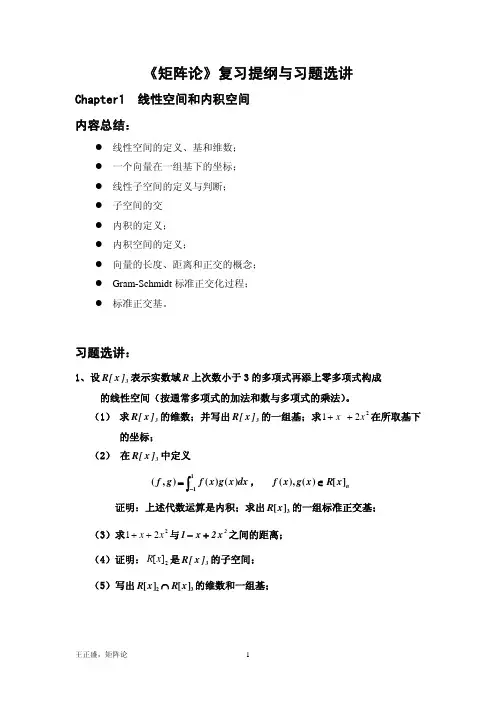
《矩阵论》复习提纲与习题选讲Chapter1 线性空间和内积空间内容总结:z 线性空间的定义、基和维数;z 一个向量在一组基下的坐标;z 线性子空间的定义与判断;z 子空间的交z 内积的定义;z 内积空间的定义;z 向量的长度、距离和正交的概念;z Gram-Schmidt 标准正交化过程;z 标准正交基。
习题选讲:1、设表示实数域3]x [R R 上次数小于3的多项式再添上零多项式构成 的线性空间(按通常多项式的加法和数与多项式的乘法)。
(1) 求的维数;并写出的一组基;求在所取基下的坐标;3]x [R 3]x [R 221x x ++ (2) 在中定义3]x [R , ∫−=11)()(),(dx x g x f g f n x R x g x f ][)(),(∈ 证明:上述代数运算是内积;求出的一组标准正交基;3][x R (3)求与之间的距离;221x x ++2x 2x 1+−(4)证明:是的子空间;2][x R 3]x [R (5)写出2[][]3R x R x ∩的维数和一组基;二、 设22R ×是实数域R 上全体22×实矩阵构成的线性空间(按通常矩阵的加 法和数与矩阵的乘法)。
(1) 求22R ×的维数,并写出其一组基;(2) 在(1)所取基下的坐标; ⎥⎦⎤⎢⎣⎡−−3111(3) 设W 是实数域R 上全体22×实对称矩阵构成的线性空间(按通常矩阵的加法和数与矩阵的乘法)。
证明:W 是22R ×的子空间;并写出W 的维数和一组基;(4) 在W 中定义内积, )A B (tr )B ,A (T =W B ,A ∈求出W 的一组标准正交基;(5)求与之间的距离; ⎥⎦⎤⎢⎣⎡0331⎥⎦⎤⎢⎣⎡−1221 (6)设V 是实数域R 上全体22×实上三角矩阵构成的线性空间(按通常矩阵的加法和数与矩阵的乘法)。
证明:V 也是22R ×的子空间;并写出V 的维数和一组基;(7)写出子空间的一组基和维数。
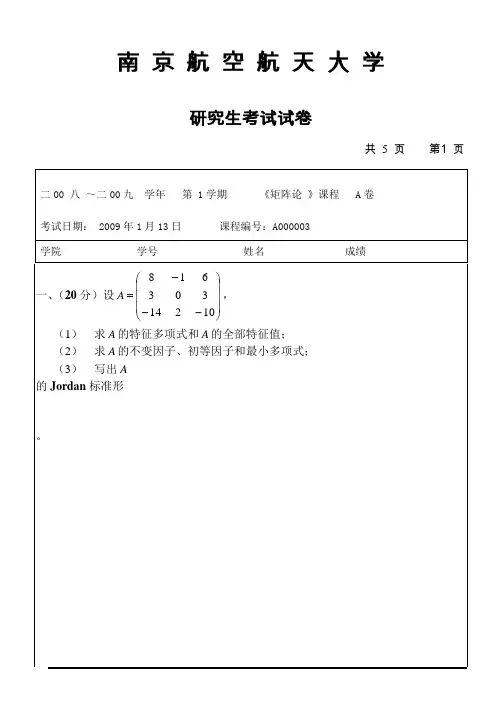
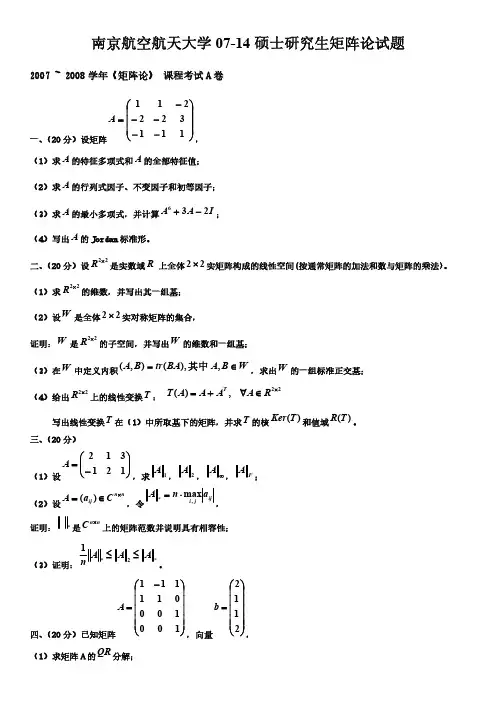
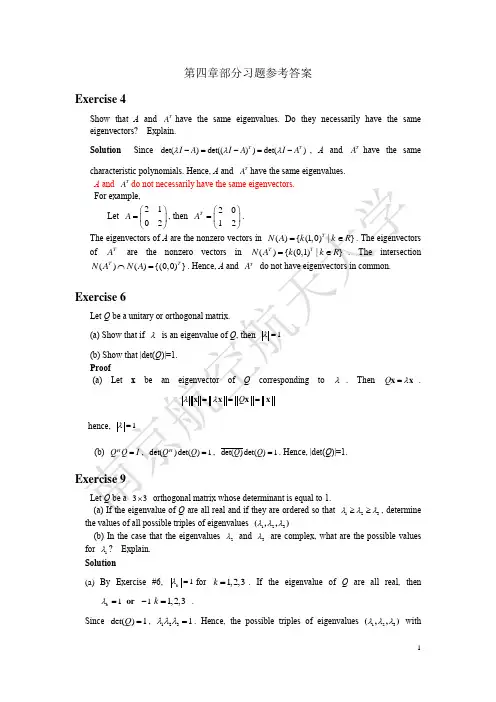
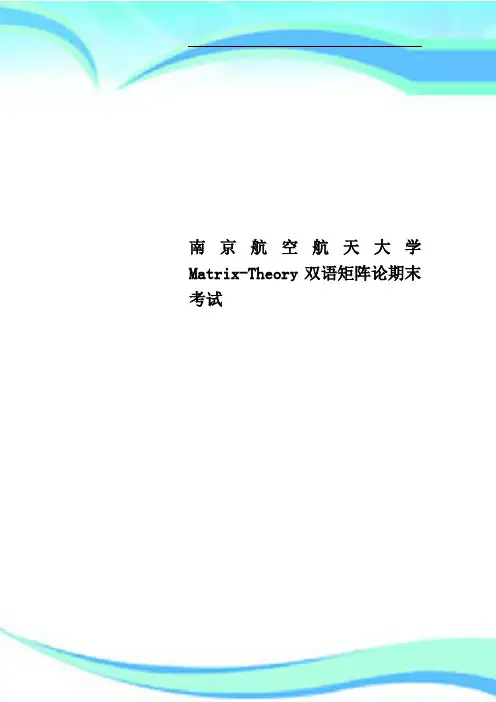

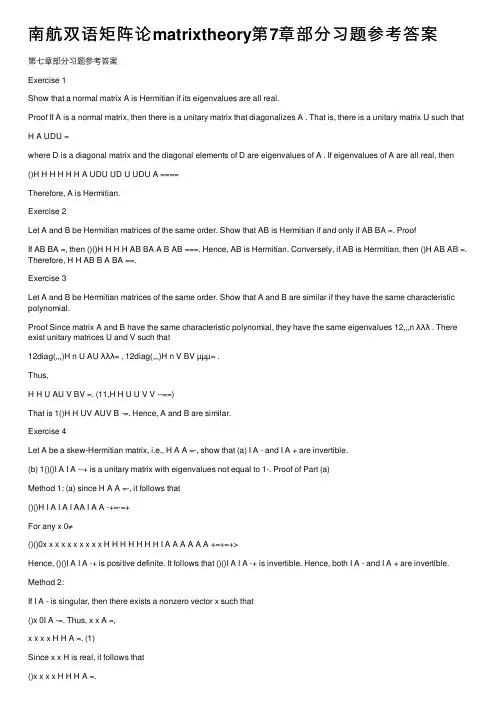
南航双语矩阵论matrixtheory第7章部分习题参考答案第七章部分习题参考答案Exercise 1Show that a normal matrix A is Hermitian if its eigenvalues are all real.Proof If A is a normal matrix, then there is a unitary matrix that diagonalizes A . That is, there is a unitary matrix U such that H A UDU =where D is a diagonal matrix and the diagonal elements of D are eigenvalues of A . If eigenvalues of A are all real, then ()H H H H H H A UDU UD U UDU A ====Therefore, A is Hermitian.Exercise 2Let A and B be Hermitian matrices of the same order. Show that AB is Hermitian if and only if AB BA =. ProofIf AB BA =, then ()()H H H H AB BA A B AB ===. Hence, AB is Hermitian. Conversely, if AB is Hermitian, then ()H AB AB =. Therefore, H H AB B A BA ==.Exercise 3Let A and B be Hermitian matrices of the same order. Show that A and B are similar if they have the same characteristic polynomial.Proof Since matrix A and B have the same characteristic polynomial, they have the same eigenvalues 12,,,n λλλ . There exist unitary matrices U and V such that12diag(,,,)H n U AU λλλ= , 12diag(,,,)H n V BV µµµ= .Thus,H H U AU V BV =. (11,H H U U V V --==)That is 1()H H UV AUV B -=. Hence, A and B are similar.Exercise 4Let A be a skew-Hermitian matrix, i.e., H A A =-, show that (a) I A - and I A + are invertible.(b) 1()()I A I A --+ is a unitary matrix with eigenvalues not equal to 1-. Proof of Part (a)Method 1: (a) since H A A =-, it follows that()()H I A I A I AA I A A -+=-=+For any x 0≠()()0x x x x x x x x x x H H H H H H H I A A A A A A +=+=+>Hence, ()()I A I A -+ is positive definite. It follows that ()()I A I A -+ is invertible. Hence, both I A - and I A + are invertible. Method 2:If I A - is singular, then there exists a nonzero vector x such that()x 0I A -=. Thus, x x A =,x x x x H H A =. (1)Since x x H is real, it follows that()x x x x H H H A =.That is x x x x H H H A =. Since H A A =-, it follows thatx x x x H H A -= (2)Equation (1) and (2) implies that 0x x H =. This contradicts the assumption that x is nonzero. Therefore, I A - is invertible. Method 3:Let λ be an eigenvalue of A and x be an associated eigenvector. x x A λ=x x x x H H A λ=. ()x x x x x x x x x x x xH H H H H H H H A A A λλ===-=-Hence, λ is either zero or pure imaginary. 1 and 1- can not be eigenvalues of A . Hence, I A -and I A + are invertible.Method 4: Since H A A =-, A is normal. There exists a unitary matrix U such that 12diag(,,,)H n U AU λλλ=12()()diag(,,,)H H H H H H n U AU U A U U AU ==-= 12diag(,,,)n λλλ= 12diag(,,,)n λλλ- Each j λ is pure imaginary or zero. 12(diag(,,,))H n I A U I U λλλ-=-12diag(1,1,,1))H n I A U U λλλ-=---Since 10i λ-≠ for 1,2,,j n = , det ()0I A -≠. Hence, I A - is invertible. Similarly, we can prove that I A + is invertible.Proof of Part (b) Method 1:Since ()()()()I A I A I A I A +-=-+, it follows that11[()()]()()H I A I A I A I A ---+-+11()()()()H H I A I A I A I A --=+--+ ( Note that 11()()H H P P --= if P is nonsingular.)11()()()()I A I A I A I A --=-+-+ 11()()()()I A I A I A I A I --=--++=Hence, 1()()I A I A --+ is a unitary matrix. Denote 1()()B I A I A -=-+.Since 111(1)(1)()()()()2()I B I I A I A I A I A I A I A -----=---+=-++-+=-+,1det()(2)det[()]0n I B I A ---=-+≠Hence, 1- can not be an eigenvalue of 1()()I A I A --+. Method 2:By method 4 of the Proof of Part (a),12diag(1,1,,1))H n I A U U λλλ-=---12diag(1,1,,1))H n I A U U λλλ+=+++1()()I A I A --+1212111diag(,,,))111H n nU U λλλλλλ---=+++ The eigenvalues of 1()()I A I A --+ are1212111,,,111n nλλλλλλ---+++ , which are all not equal to 1-.Method 3: Since ()()()()I A I A I A I A +-=-+, it follows that11()()()()I A I A I A I A ---+=+-If 1- is an eigenvalue of 1()()I A I A --+, then there is a nonzero vector x , such that1()()x x I A I A --+=-. That is 1()()x x I A I A -+-=-.It follows that()()x x I A I A -=-+.This implies that x 0=. This contradiction shows that 1- can not be an eigenvalue of1()()I A I A --+.Exercise 6If H is Hermitian, show that i I H - is invertible, and 1(i )(i )U I H I H -=+- is unitary. Proof Let i A H =-. Then A is skew-Hermitian. By Exercises #4, I A - and I A + are invertible, and 1()()U I A I A -=-+ is unitary. This finishes the proof.Exercise 7Find the Hermitian matrix for each of the following quadratic forms. And reduce each quadratic form to its canonical form by a unitary transformation (a) 12312131213(,,)i i f x x x x x x x x x x x =+-+ Solution()1123123230i 1(,,)i 00100x f x x x x x x x x ???? ???=- ??? , 0i 1i 00100A ?? ?=- ? ???3d e t ()2I A λλλ-=-. Eigenvalues of Aare 1λ=2λ=30λ=.Associated unit eigenvectors are1i 1,)22u T =-, 2i 1,)22u T =-, and3u T =, respectively. 123,,u u u form an orthonormal set.Let 123(,,)u u u U =, and x y U =. Then we obtain the canonical form1122y yExercise 9Let A and B be Hermitian matrices of order n , and A be positive definite. Show that AB issimilar to a real diagonal matrix.Proof Since A is positive definite, there exists an nonsingular Hermitian matrix P such that H A PP = 1()H H AB PP B P P BP P -==AB is similar to H P BP . Since H P BP is Hermitian, it is similar to a real diagonal matrix. Hence, AB is similar to a real diagonal matrix.Exercise 10Let A be an Hermitian matrix of order n . Show that there exists a real number 0t such that t I A +is positive definite.Proof 1: The matrix t I A + is Hermitian for real values of t . If the eigenvalues of A are12,n λλλ,,, then the eigenvalues of t I A +are 12,,n t t t λλλ+++ ,. Let 12max{,,}n t λλλ> ,Then the eigenvalues of t I A + are all positive. And hence, tI A +is positive definite.Proof 2: The matrix t I A + is Hermitian for real values of t . Let r A be the leading principle minor of A of order r .d e t ()r r r I A t +=+terms involving lower powers in t . Hence, det()r r t I A + is positive for sufficiently large t .Thus, if t is sufficiently large, all leading principal minors of t I A + will be positive.That is, there exists a real number 0t such that det()r r t I A + is positive for 0t t > and for each r . Thus t I A + is positive definite for 0t t >.Exercise 11 Let11121222H A A A A A ??=be an Hermitian positive definite matrix. Show that 1122det()det()det()A A A ≤Proof We first prove that if A is Hermitian positive definite and B is Hermitian semi-positivedefinite, then det()det()A B A +≥. Since A is positive definite, there exists a nonsingular hermitian matrix P such thatHA P P =11(())H H A B P I P B P P --+=+ 11det()det()det(())H A B A I P B P --+=+11()H I P B P --+ is positive semi- definite. Its eigenvalues are all greater than or equal to 1.Thus11det(())1H I P B P --+≥111121112112111222H H I O A A I A A A A I A A O I --??-?-11112111112112212111222121112H H A A A O I A A O A A A A O A A A A O I ---??-== ? ? ?--?122121112H A A A A -- is positive definite, and 1121112H A A A - is positive semi-definite, and11122121112det()det()det()H A A A A A A -=- Hence, 111222212111212111222121112det()det()det(H H H A A A A A A A A A A A A ---=-+≥-)This finishes the proof.Exercise 12Let A be a positive definite Hermitian matrix of order n . Show that the element in A with the largest norm must be in the main diagonal.Proof Let ()ij A a =. Suppose that 00i j a is of the largest norm, where 00i j ≠. Consider theprincipal minor 00000000i i i j i j j j a a a a ??. It must be positive definite since A is positive definite. (Recall that an Hermitian matrix is positive definite iff all its principal minors are positive.) Thus, 00000000det 0i i i j i j j j a a a a ??>. On the other hand, 000000000000002det 0i i i j i i j j i j i j j j a a a a a a a ??=-≤since 00i j a is of the largest norm.(Remark: The diagonal elements in an Hermitian matrix must be real.)This contradiction implies that the element in A with the largest norm must be in the main diagonal.。

NUAALet 3P (the vector space of real polynomials of degree less than 3) defined by(())'()''()p x xp x p x σ=+.(1) Find the matrix A representing σ with respect to the ordered basis [21,,x x ] for 3P .(2) Find a basis for 3P such that with respect to this basis, the matrix B representing σ is diagonal.(3) Find the kernel (核) and range (值域)of this transformation. Solution: (1)221022x x x x σσσ===+()()() 002010002A ⎛⎫⎪= ⎪ ⎪⎝⎭----------------------------------------------------------------------------------------------------------------- (2)101010001T ⎛⎫ ⎪= ⎪ ⎪⎝⎭(The column vectors of T are the eigenvectors of A)The corresponding eigenvectors in 3P are 1000010002T AT -⎛⎫⎪= ⎪ ⎪⎝⎭(T diagonalizes A ) 22[1,,1][1,,]x x x x T += . With respect to this new basis 2[1,,1]x x +, the representingmatrix of σis diagonal.------------------------------------------------------------------------------------------------------------------- (3) The kernel is the subspace consisting of all constant polynomials.The range is the subspace spanned by the vectors 2,1x x +-----------------------------------------------------------------------------------------------------------------------Let 020012A ⎛⎫⎪= ⎪ ⎪-⎝⎭.(1) Find all determinant divisors and elementary divisors of A .(2) Find a Jordan canonical form of A .(3) Compute At e . (Give the details of your computations.) Solution: (1)110020012I A λλλλ-⎛⎫ ⎪-=- ⎪ ⎪-⎝⎭,(特征多项式 2()(1)(2)p λλλ=--. Eigenvalues are 1, 2, 2.)Determinant divisor of order 1()1D λ=, 2()1D λ=, 23()()(1)(2)D p λλλλ==-- Elementary divisors are 2(1) and (2)λλ-- .---------------------------------------------------------------------------------------------------------------------- (2) The Jordan canonical form is100021002J ⎛⎫ ⎪= ⎪ ⎪⎝⎭--------------------------------------------------------------------------------------------------------------------------(3) For eigenvalue 1, 010010011I A ⎛⎫⎪-=- ⎪ ⎪-⎝⎭ , An eigenvector is 1(1,0,0)T p = For eigenvalue 2, 1102000010I A ⎛⎫⎪-= ⎪ ⎪⎝⎭, An eigenvector is 2(0,0,1)T p =Solve 32(2)A I p p -=, 331100(2)00000101A I p p --⎛⎫⎛⎫⎪ ⎪-== ⎪ ⎪ ⎪ ⎪-⎝⎭⎝⎭we obtain that3(1,1,0)T p =-101001010P ⎛⎫ ⎪=- ⎪ ⎪⎝⎭, 1110001010P -⎛⎫⎪= ⎪ ⎪-⎝⎭ 1At J e Pe P -=22210100110001000101000010tt t t e e te e ⎛⎫⎛⎫⎛⎫⎪ ⎪ ⎪=- ⎪ ⎪ ⎪ ⎪ ⎪ ⎪-⎝⎭⎝⎭⎝⎭22220000t t t t t t e e e e tee ⎛⎫-⎪= ⎪ ⎪-⎝⎭ --------------------------------------------------------------------------------------------------------------------Suppose that ∈R A and O I A A =--65.(1) What are the possible minimal polynomials of A ? Explain.(2) In each case of part (1), what are the possible characteristic polynomials of A ? Explain.Solution:(1) An annihilating polynomial of A is 256x x --.The minimal polynomial of A divides any annihilating polynomial of A. The possible minimal polynomials are6x -, 1x +, and 256x x --.---------------------------------------------------------------------------------------------------------------(2) The minimal polynomial of A divides the characteristic polynomial of A. Since A is a matrix of order 3, the characteristic polynomial of A is of degree 3. The minimal polynomial of A and the characteristic polynomial of A have the same linear factors. Case 6x -, the characteristic polynomial is 3(6)x - Case 1x +, the characteristic polynomial is 3(1)x + Case 256x x --, the characteristic polynomial is 2(1)(6)x x +- or 2(6)(1)x x -+-------------------------------------------------------------------------------------------------------------------Let 120000A ⎛⎫=⎪⎝⎭. Find the Moore-Penrose inverse A +of A .Solution: ()12011200000A PG ⎛⎫⎛⎫=== ⎪ ⎪⎝⎭⎝⎭1()(1,0)T T P P P P +-==, 111()250T T G G GG +-⎛⎫⎪== ⎪ ⎪⎝⎭110112(1,0)2055000A G P +++⎛⎫⎛⎫ ⎪⎪=== ⎪ ⎪ ⎪ ⎪⎝⎭⎝⎭也可以用SVD 求.------------------------------------------------------------------------------------------------------------------Part II (选做题, 每题10分)请在以下题目中(第6至第9题)选择三题解答. 如果你做了四题,请在题号上画圈标明需要批改的三题. 否则,阅卷者会随意挑选三题批改,这可能影响你的成绩.Let 4P be the vector space consisting of all real polynomials of degree lessthan 4 with usual addition and scalar multiplication. Let 123,,x x x be three distinct real numbers. For each pair of polynomials f and g in 4P , define 31,()()i i i f g f x g x =<>=∑.Determine whether ,f g <> defines an inner product on 4P or not. Explain.Let n n A ⨯∈R . Show that if x x A =)(σis the orthogonal projection fromn R to )(A R , then A is symmetric and the eigenvalues ofA are all 1’s and 0’s.n n A ⨯∈C . Show that x x A H is real-valued for all n C x ∈if and only if Ais Hermitian.Let n n B A ⨯∈C , be Hermitian matrices, and A bepositive definite. Show thatAB is similar to BA , and is similar to a real diagonal matrix.若正面不够书写,请写在反面.123()()()x x x x x x ---. Then ,0f f <>=. But 0f ≠. This does not define an inner product. For any x , ()()x x T A R A N A ⊥-∈=, ()x x 0T A A -=. Hence, T T A A A =. Thus. T A A =.From above, we have 2A A =. This will imply that λλ-2is an annihilating polynomial of A. The eigenvalue of A must be the roots of 02=-λλ. Thus, the eigenvalues of A are1’s and 0’s.See Thm 7.1.1, page 182. 也可以用其它方法.Since A is nonsingular, 1()AB A BA A -=. Hence, A is similar to BASince A is positive definite, there is a nonsingular hermitian matrix P such that H A PP =. 1()H H AB PP B P P BP P -==Since H P BP is Hermitian, it is similar to a real diagonal matrix.is similar to H AB P BP , H P BP is similar to a real diagonal matrix. Thus AB is similar to a real diagonal matrix.。
南京航空航天大学矩阵论历年试题整理者:王正华2007.1.28一 设2615115126A −=− −(1)求A 的特征多项式和A 的全部特征值;(2)求A 的行列式、不变因子,初等因子; (3)求A 的最小多项式; (4)写出A 的Jordan 标准形二(1)设210121A= −,1)求12,,,F A A A A ∞;(2)设A 为n阶矩阵,证明21,max ij i j na A∞≤≤≤≤三(1)111111112A − =− −,作出A 的满秩分解并求出A +;(2)利用该矩阵判断如下方程组1231231231121x x x x x x x x x −+=−++=− −+= ,是否相容?若相容求通解;若不相容,求极小最小二乘解四 设V 是数域P 上全体3阶实对称矩阵作成的线性结构(1)求V 的维数,并写出一组基(2)在V 中定义变换100100()011010001011T X X=,证明T 是线性变换,并求T 在(1)中所取基下的矩阵五(1)设2010252,022024220t A t B −==,其中t 是实数,t 满足什么条件时A B >成立?(2)设,A B 均为Hermite 半正定矩阵,证明:○1若A >0, 则AB 相似于半正定对角阵; ○2若A >0, 则()00tr AB B =⇒=; ○3若()0,tr AB = 则0AB =一(20分) 已知 A =1001225i i −,其中i(1)求12,,,F A A A A ∞(2)证明:A ≥0 (3)设,,nH c B αβαβ∈=,证明22FBαβ=二(20分) 设A =110101101211 ,b =314(1)作出A 的满秩分解 (2) 计算A +(3)利用广义逆矩阵方法判断线性方程组A x =b 是否相容?若相容,求其通解,若不相容,求其极小最小二乘解三(20分) 设A =110430211− − −(1)求A 的特征多项式和A 的全部特征值(2)求A 的不变因子、初等因子和最小多项式 (3)写出A 的Jordan 标准形(4)设A 为n 阶矩阵,证明:A 非奇异的充要条件是存在常数项不为零的多项式()f x ,使()f x =0 四(20分) (1)设A 、B 均为Hermite 矩阵(n 阶),且A B =B A ,证明: (a )如果A >0,且A B >0 , 则B >0(b )如果A >0, B >0,且33A B >,则A B >(2)若A 是2阶实正规矩阵,且i αβ±是A 的一对共轭实特征值,证明:存在正交矩阵Q ,使得Q AQ αββα+ =−五(20分) 设实数域上线性空间32R ×的子集W =22{,()0}A R tr A ×∈=(1)W 是22R×的子空间(2)给出W 的变换T (A )=A A ++,A W ∀∈,证明:T 是W 上的线性变换 (3)求Ker (T )及其维数(4)求W 的一组基和维数,并写出线性变换T 在所取基下的矩阵一 (20分)设[]n R X 表示实数域R 上次数小于n 的多项式再添上零多项式构成的线性空间(按通常多项式的加法和数与多项式的乘法)(1)求[]n R X 的维数并写出[]n R X 的一组基;(2)在[]n R X 中定义线性变换D :(())'(),()[]n D f x f x f x R x =∈,求D 在(1)中所取基下的矩阵表示,并求R (D )和Ker (D )(3)证明D 在任何一组基下的矩阵都不可能是对角矩阵(4)在[]n R X 中定义内积11(,)()(),f g f x g x dx −=(),()[]n f x g x R X ∈,求出3[]R X 的一组标准正交基二 (20分)设A =3615125125− −−三 (16分)(1)设A =11121013 − −,求12,,,F A A A A ∞ (2)设A 为n 阶矩阵,证明:()1A ρ<的充要条件是存在某种相容矩阵范数.,使得1A <四(14分)设111021111021A − −−=(1) 作出A 的一个QR 分解,即求满足T Q Q I =的4×3矩阵和3阶上三角矩阵R ,使得A QR = (2) 计算A +五 (16分)(1)设311120102A − = − ,121211111B =,问A ≥B 是否成立 (2)设A 为n 阶Hermite 正定矩阵,B 为n 阶Hermite 半正定矩阵,并且AB BA =,证明 (i )AB 为Hermite 半正定矩阵 (ii )如果A ≥B ,则2A ≥2B六 (14分)(1)设222i i A i i i i =− −−,其中i =,证明A 是正定矩阵; (2)若n n A C ×∈,且21A<,则A >B ≥0(3)设,n n A B C ×∈是Hermite 矩阵,证明如果A >B ≥0,则A B −≤A ,且等号成立一(20分)(1)设A 为n 阶非奇异复矩阵,试述矩阵A 的QR 分解定理;(2)设110101111010A= −(i )作出A 的一个满秩分解 (ii )计算广义逆矩阵A +二(18分)(1)设210123032A=− −,求12,,,F A A A A ∞;(2)设A 为n 阶可逆矩阵,.是满足1I =的矩阵范数,证明11AA −−≥,21A ≤三(22分)设3117937100480024A −−−−−= − −(1) 求A 的特征多项式和A 的全部特征值; (2) 求A 的不变因子、初等因子和最小多项式; (3) 写出A 的Jordan 标准形; (4) 求lim k k A →∞;(5) 计算Ae 四(20分)(1)设622250207A −=−,证明A 为正定矩阵;(2)设A ,B 均为Hermite 矩阵,证明:(i ) 如果A >0, 则A B 相似于对角矩阵;(ii ) 如果A >0, B >0, 则A B 的特征值均为正数;(iii ) 如果A >0, B >0,且A B =B A ,则A B 是Hermite 正定矩阵五(20分)设V 是实数域R 上全部3阶实反对称矩阵作成的线性空间(按矩阵的加法和数量乘法)(1) 求V 的维数,并写出V 的一组基;(2) 证明:若A 是3阶实对称矩阵,且X V ∈,则必有AX XA V +∈; (3) 作映射T 如下:011011()101101,110110T X X X X V −−=+∈ −−证明:T 是V 上的线性变换;(4) 求T 在(1)中所取基下的矩阵表示。
硕士研究生考试试卷 2014— 2015学年第一学期 考试科目: 矩阵论 考试时间:120分钟 出卷教师: 出卷时间: 阅卷负责人签名:姓名、学号必须写在指定位置 1 填空题 (18分) (1)123654789A ⎡⎤⎢⎥=⎢⎥⎢⎥⎣⎦,111X ⎡⎤⎢⎥=⎢⎥⎢⎥⎣⎦,则1A = m A ∞= 1AX = AX ∞= (2)1821A -⎡⎤=⎢⎥-⎣⎦,幂级数06k k k k z ∞=∑的收敛半径是 , 矩阵幂级数06k k k k A ∞=∑是 (收敛、发散),理由 (3)1210A -⎡⎤=⎢⎥-⎣⎦,0110B ⎡⎤=⎢⎥⎣⎦,则A B ⊗的全部特征值是(4)123b b b α⎡⎤⎢⎥=⎢⎥⎢⎥⎣⎦是给定的向量,123X ξξξ⎡⎤⎢⎥=⎢⎥⎢⎥⎣⎦是向量变量,且112233()f X b b b ξξξ=++,则dfdX =专业:姓名:学号:2 设110430102A-⎡⎤⎢⎥=-⎢⎥⎢⎥⎣⎦,(16分)(1)求A的Jordan标准形J (2)求变换矩阵P,使1P AP J-=3 设221022212A⎡⎤⎢⎥=⎢⎥⎢⎥⎣⎦,求A的QR分解(12分)4 设101102221453A-⎡⎤⎢⎥=⎢⎥⎢⎥-⎣⎦(16分)(1)求A的满秩分解(2)求A的More-Penrose逆A+5设20312102810A⎡⎤⎢⎥=⎢⎥⎢⎥⎣⎦(14分)(1)写出A的行盖尔圆,并在复平面上画图表示(2)隔离A的特征值(3)利用实矩阵特征值性质,改进得到的结果6 设()m nij m n A a C ⨯⨯=∈,规定,ijG i j A a = (12分)(1) 证明G ⋅是m n C ⨯上的一种范数(2) 证明矩阵范数与向量2-范数相容7 求解微分方程初值问题 (12分)11221221431dx x x dt dx x x dt ⎧=++⎪⎪⎨⎪=+-⎪⎩,12(0)1,(0)2x x ==。
Solution Key (chapter 1)Exercise 2.The show that this set is not closed under multiplication.TakeS ,2=.But 2S ∉.If 2S ∈rational numbers a and b ,such that2=It is clear that 0a ≠and0b ≠.)This will 224232a b ab --=The right hand is a rational number and the left hand side is an irrational number.This is impossible.Thus,S is not closed under multiplication.Hence,S is not a field.Exercise 7.zx y x +=+)()()()(z x x y x x ++-=++-z x x y x x ++-=++-])[(])[(z 0y 0+=+zy =Exercise 12It is a vector space.A1:A2:,Hence,A3:The existence of the zero element .The zero element must satisfy that for any ,That is for any ,.We obtain that the zero element is A4:The existence of additive inverse.For each ,its additive inverse is ,since.(Note that is the zero element of )M1:M2:M3:M4:Exercise 13.(a)No,it is not a subspace.Denote the set by S .Take 2()p x x x S =+∈,2()q x x x S =-+∈.Then ()()2p x q x x S +=∉.S is not closed under addition.Hence,S is not a subspace.(Or:The set S does not contain the zero polynomial,hence,is not a subspace.)(b)Denote the set by S .(b)Take 3()1p x x S =+∈,3()1p x x S =-+∈.Then ()()2p x q x S +=∉.S is not closed under addition.Hence,S is not a subspace.(Or:The set S does not contain the zero polynomial,hence,is not a subspace.)(c)Yes,it is a subspace.Check that this set is closed under addition and scalar multiplication.(d)No,it is not a subspace.Denote the set by S .Take ()1p x x S =+∈,()1p x x S =-+∈,()()2p x q x S +=∉.S is not closed under addition.Hence,S is not a subspace.Exercise 15.(a)Yes,it is a subspace.Check that this set is closed under addition and scalar multiplication.(b)Yes,it is a subspace.Check that this set is closed under addition and scalar multiplication.(c)Denote the set by S .Take ()p x x S =∈.But (1)()p x x S -=-∉.Thus,the set S is not closed under scalar multiplication.Hence,S is not a subspace.(d)Yes,it is a subspace.Check that this set is closed under addition and scalar multiplication.(e)Denote the set by S .Take ()1p x x S =-∈()1q x x S =+∈.But ()()2p x q x x S +=∉.S is not closed under addition.Hence,S is not a subspace.Exercise 17.Since 12{,,,}u v v v i s span ∈ for each i ,all combinations of 12,,,u u u r are also in12{,,,}v v v s span .Thus,12{,,,}u u u r span is a subspace of 12{,,,}v v v s span .Therefore,12dim({,,,})u u u r span ≤ 12dim({,,,})v v v s span .Exercise 19By Taylor expansion formula()110(1)()32(1)!j n n j j f f x x x j --==+=-∑22(1)(2)512(1)(1)(1)2!n n n x x --=⋅+-⋅-+-+ 12(1)(2)()(1)2(1)!j n n n n j x x j ----+-++- The coordinate vector is 2(1)(2)2(1)(2)()5,2(1),,,,,2)Tn n n n n j n ------ (Exercise 22Use the definition of the transition matrix.111011001⎛⎫ ⎪ ⎪ ⎪⎝⎭Exercise 25.(b)Let 12(,,,)b b b n B = .Then 12(,,,)b b b n AB A A A = .If AB O =,then b 0i A =for 1,2,,i n = .()b i N A ∈for 1,2,,i n = .All linear combinations of 12,,,b b b n are also in ()N A .Thus,()()R B N A ⊂.()R B is a subspace of ()N A .If ()R B is a subspace of ()N A ,then for each column b i of B ,we must haveb 0i A =.Hence,12(,,,).b b b n AB A A A O == (b)By part (a),we know that ()R B is a subspace of ()N A .Thus,()dim(())dim(())r B R B N A =≤.By the rank-nullity theorem,we obtain that ()()dim(())()r B r A N A r A n+≤+=Exercise 26.(a)Hint:First,show that each column vector of C is a linear combination of the column vectors of A.Then,linear combinations of the column vectors of C are linear combinations of the column vectors of A.(b)Hint:First,show that each row vector of C is a linear combination of the row vectors of B.Then,linear combinations of the row vectors of C are linear combinations of the row vectors of B.(c)By (a)and (b),()dim(())dim(()()rank C R C R A rank A =≤=And ()dim(())dim(())()T rank C R C R B rank B =≤=Thus,()min{(),()}rank C rank A rank B ≤Exercise 27.(a)Hint:The column vectors of C are linearly independent if and only if the system 0x C =has only the trivial solution (the zero solution).If ()0x AB =,then ()0x A B =.x B must be zero since the column vectors of A are linearly independent.Thar is,0x B =.Since the column vectors of B are linearly independent,x must be zero.(b)Hint:T T T C B A =.Column vectors of T A are linearly independent.Column vectors of T B are linearly independent.The row vectors of C are linearly independent if and only if the column vectors of T C are linearly independent.Then apply part(a).Exercise 29.Let ,A B S ∈.Then ()T T T A B A B A B +=+=+,and ()T T kA kA kA ==.S is closed under addition and scalar multiplication.Thus,S is a subspace of n nR ⨯Let ,A B K ∈.Then ()()T T T A B A B A B A B +=+=--=-+,and ()()T T kA kA kA ==-.Kis closed under addition and scalar multiplication.Thus,K is a subspace of n n R ⨯The proof of n n R S K ⨯=⊕.Let .n n A R ⨯∈Then 11()()22T T A A A A A =++-.1()2T A A +is symmetric and 1()2T A A -is anti-symmetric.This show that n n R S K ⨯=+.Next,we show that the sum S K +is a direct sum.If A S K ∈⋂,then we have both TA A =and TA A =-.This will imply that A A =-.Thus,A must be the zero matrix.This proves that the sum S K +is a direct sum.Exercise 32.Let ij E denote the matrix whose (,)i j entry is 1,zero elsewhere.ij F denote the matrix whose (,)i j entry is 1-,zero elsewhere.Forany ()m n ij ij A a C ⨯=+∈,where ,ij ij a b are real numbers,A can be written as1111n m n mij ij ij ij j i j i A a E b F =====+∑∑∑∑.This shows that the matrices {,|1,2,,,1,2,,} ij ij E F i m j n == forms a spanning set for m n C ⨯.If 1111n m n m ij ij ij ij j i j i a E b F O ====+=∑∑∑∑,then 0ij ij a =for 1,2,,i m = ,1,2,,j n = .Thus,we must have 0ij ij a b ==for 1,2,,i m = ,1,2,,j n = .Therefore,{,|1,2,,,1,2,,} ij ij E F i m j n == forms a basis for m nC ⨯.Thedimensionis 2mn .Note that,all coefficients of linear combinations must be real numbers because theunderlying field is the real number field.。